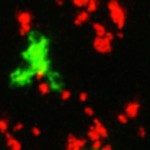Link to Pubmed [PMID] – 26795248
Immunity 2016 Jan;44(1):143-154
Allogeneic hematopoietic stem cell transplantation (allo-HSCT), a curative treatment for hematologic malignancies, relies on donor cytotoxic T lymphocyte (CTL)-mediated graft-versus-leukemia (GVL) effect. Major complications of HSCT are graft-versus-host disease (GVHD) that targets specific tissues and tumor relapses. However, the mechanisms dictating the anatomical features of GVHD and GVL remain unclear. Here, we show that after HSCT, CTLs exhibited different killing activity in distinct tissues, being highest in the liver and lowest in lymph nodes. Differences were imposed by the microenvironment, partly through differential PD-1 ligand expression, which was strongly elevated in lymph nodes. Two-photon imaging revealed that PD-1 blockade restored CTL sensitivity to antigen and killing in lymph nodes. Weak CTL activity in lymph nodes promoted local tumor escape but could be reversed by anti-PD-1 treatment. Our results uncover a mechanism generating an anatomical segregation of CTL activity that might dictate sites of GVHD and create niches for tumor escape.


